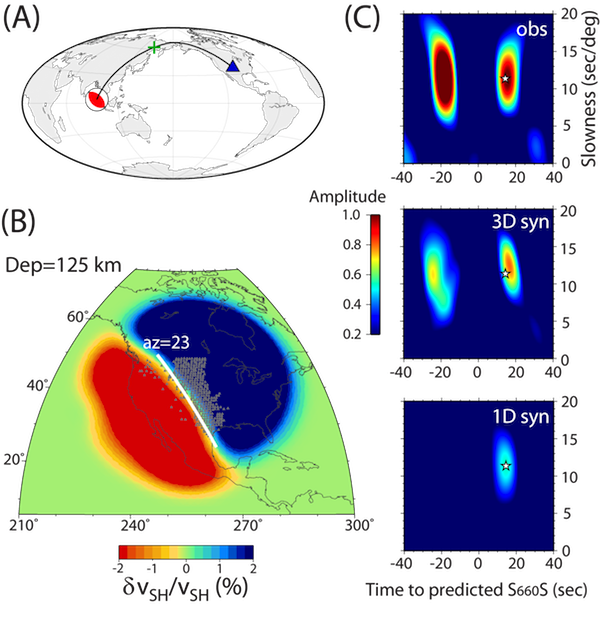2012 IRIS Workshop
Apparent “double SS precursors”: artifacts from scattering at the Rocky Mountain Front
Zhao Zheng: University of California, Berkeley, Barbara Romanowicz: University of California, Berkeley; College de France.
(A) SS ray path from an mb 6.7 event (beachball) to US Transportable Array (triangle). The cross marks the bounce point. (B) A slice of the 3D tomographic model S362ANI beneath North America. The boundary between slower western US and faster craton follows the great circle path of 23° azimuth (white curve). Gray dots mark TA stations. (C) Vespagrams of the observations, 3D and 1D (PREM) synthetics in the precursor time window. The stars denote the maximum on the vespagram of the 1D synthetics.

Full-resolution graphics file in original format: 0131.png
SS precursors are the underside reflections from the upper mantle discontinuities such as 410 and 660. They are important tools for studying the existence and characteristics of upper mantle discontinuities both on the global and regional scales. Due to their sensitivity at the midpoint between source and receiver, coverage for oceanic regions is achieved where other methods such as receiver functions and triplications are not feasible. The amplitudes of the precursors are generally small (5-10% of the main phase), at or below the noise level. Stacking is therefore necessary for signal enhancement. Mid-point stacking over geographical bins with radius of 10° has been common. On the other hand, the deployment of the US Transportable Array (TA) allows unprecedented density of ray coverage and therefore brings new opportunities to try and resolve finer scale discontinuity characteristics for much broader regions. Here we present observations of SS precursors from an mb 6.7 earthquake recorded at TA in 2010. In this particular case, the S670S precursors on the transverse component are strong enough to be identified on individual seismograms across the array without any stacking. Two coherent signals around the expected S660S arrival are observed, seeming to suggest a double discontinuity around 660 km depth in the bounce point region. We then conduct 1D and 3D modeling. While only one S660S is present on the 1D synthetics as expected, “double precursors” are seen on 3D synthetics with correct slownesses, although only one 660 discontinuity is present in the model, which is intriguing. Further analysis reveals that the apparent “double precursors” are artifacts due to heterogeneities in the upper mantle near the receivers away from the bounce point region. Our findings challenge the common interpretation of double SS precursors in terms of complex mineralogical transitions and call for caution in identifying and interpreting SS precursors.
Acknoweldgements: Waveform data used in this study were obtained from the IRIS data center. This work was supported by NSF EAR grant # 0738284.
For further reading: Zheng, Z. and B. Romanowicz (2012), Do double “SS precursors” mean double discontinuities?, submitted to Geophys. J. Int.
Keywords: ss_precursors, upper_mantle_discontinuities, seismic_wave_scattering
